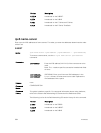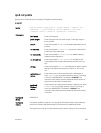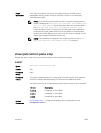
Version Description
8.3.19.0 Introduced on the S4820T.
8.3.11.1 Introduced on the Z9000.
8.3.7.0 Introduced on the S4810.
8.3.2.0 Introduced on the E-Series TeraScale, C-Series, and S-
Series.
Usage
Information
By default, all prefixes configured as addresses on the interface are advertised. This
command allows control over the individual parameters per prefix; you can use the
default keyword to use the default parameters for all prefixes. If a prefix has been
configured with lifetime parameter values, the default values cannot be applied
using the ipv6 nd prefix default no-autoconfig command.
ipv6 route
Establish a static IPv6 route.
S4820T
Syntax
ipv6 route [vrf vrf-name] ipv6-address prefix-length {ipv6-
address | interface | interface ipv6-address} [distance] [tag
value] [permanent] [weight weight-value]
To remove the IPv6 route, use the no ipv6 route [vrf vrf-name]ipv6-
address prefix-length {ipv6-address | interface | interface
ipv6-address} [distance] [tag value] [permanent] [weight]
command.
Parameters
vrf vrf-name (Optional) Enter the keyword vrf followed by the name of the
VRF to install IPv6 routes in that VRF.
ipv6-address
prefix-length
Enter the IPv6 address in the x:x:x:x::x format then the prefix
length in the /x format. The range is from /0 to /128.
NOTE: The :: notation specifies successive hexadecimal
fields of zeros.
interface (OPTIONAL) Enter the following keywords and slot/port or
number information:
• For a 10-Gigabit Ethernet interface, enter the keyword
TenGigabitEthernet then the slot/port information.
• For a 40-Gigabit Ethernet interface, enter the keyword
fortyGigE then the slot/port information.
• For a Loopback interface, enter the keyword loopback
then a number from 0 to 16383.
998
IPv6 Basics


















